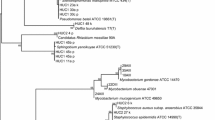Summary
The presently recognized anaerobic bacteria of clinical interest, with the possible exception of some spirochaetes, can be cultured by conventional procedures with an anaerobic jar. Care and attention to detail in the design and operation of an anaerobic jar are essential. Anaerobic cabinets and oxygen-free gassing systems may contribute to further research and development, but the potential usefulness of a good anaerobic jar in clinical bacteriology should not be under-rated.
Zusammenfassung
Die gegenwärtig anerkannten anaeroben Bakterien mit klinischer Bedeutung könne, mit der möglichen Ausnahme einiger Spirochäten, mit konventionellen Methoden in einem Anaerobiertopf gezüchtet werden. Sorgfalt und Aufmerksamkeit bis ins einzelne sind im Aufbau und beim Betrieb eines Anaerobiertopfes wesentlich. Anaerobierkammern und sauerstofffreie Begasungssysteme können zur weiteren Erforschung und Entwicklung beitragen, aber der potentielle Nutzen eines guten Anaerobiertopfes in der klinischen Bakteriologie sollte nicht unterschätzt werden.
Similar content being viewed by others
Literature
Collee, J. G., Rutter, J. M., Watt, B. The significantly viable particle: A study of the subculture of an exacting sporing anaerobe. J. Med. Microbiol. 4 (1971) 271–287.
Watt, B. The recovery of clinically important anaerobes on solid media. J. Med. Microbiol. 5 (1972) 211–218.
Watt, B., Collee, J. G., Brown, R. The isolation of strict anaerobes: the use of an anaerobic cabinet compared with a conventional procedure. J. Med. Microbiol. 7 (1974) 315–324.
Willis, A. T. Anaerobic bacteriology. Clinical and laboratory practice. Butterworths, London 1977, p. 1.
Wren, M. W. D., Baldwin, A. W. F., Eldon, C. P., Sanderson, P. J. The anaerobic culture of clinical specimens: A 14-months study. J. Med. Microbiol. 10 (1977) 49–61.
Wren, M. W. D. The culture of clinical specimens for anaerobic bacteria: A comparison of three regimens. J. Med. Microbiol. 10 (1977) 195–201.
Watt, B., Collee, J. G., Brown, R. Tests of performance of anaerobic jars. J. Clin. Pathol. 29 (1976) 534–536.
Collee, J. G., Watt, B., Fowler, E. G., Brown, R. An evaluation of the GasPak system in the culture of anaerobic bacteria. J. Appl. Bacteriol. 35 (1972) 71–82.
Watt, B. The influence of carbon dioxide on the growth of obligate and facultative anaerobes on solid media. J. Med. Microbiol. 6 (1973) 307–314.
Author information
Authors and Affiliations
Rights and permissions
About this article
Cite this article
Collee, J.G. Prompt and reliable culture of exacting anaerobic bacteria in anaerobic jars. Infection 8 (Suppl 2), S150–S152 (1980). https://doi.org/10.1007/BF01639878
Issue Date:
DOI: https://doi.org/10.1007/BF01639878




